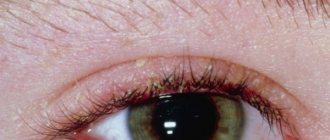Why do eyes turn red during colds and acute respiratory viral infections?
During the autumn-winter period, viral and infectious diseases often occur.
They are accompanied by characteristic clinical symptoms such as fever, coughing, sneezing, and redness of the conjunctiva of the eyes.
For each of the listed signs, there is a specific treatment that will help prevent complications after ARVI. It is recommended to consult a doctor so that he can select the drug individually for each patient.
If the conjunctiva of the eyes turns red in a patient with a cold, this condition is caused by the following reasons:
- a complication from the underlying disease, which forms in the form of a viral or infectious lesion of the conjunctiva;
- release of waste products by a viral agent that have a toxic effect on the human body, including the organs of vision;
- the individual sensitivity of the eyes of a person whose conjunctiva turns red when a cold occurs;
- a sharp increase in body temperature, causing an increase in blood flow in the microcirculation vessels of the eyes.
If the redness is caused by an individual symptom, no treatment is required. The condition will go away on its own. When a symptom develops due to pathological reactions, it is important to carry out symptomatic and pathogenetic therapy.
If redness appears in the eye area during a cold, the condition is accompanied by the development of the following symptoms:
- sensation of a foreign object under the eyelids;
- the formation of an inflammatory process that spreads to the cornea, conjunctiva, mucous membrane, eyelids;
- swelling of the eyes;
- production of clear or purulent secretion, depending on the factor causing the disease;
- increased sensitivity of the eyes to exposure to bright light;
- increased production of tear fluid;
- Sometimes itching and burning occurs in the eyes.
The disease may be accompanied by one or more of the above symptoms.
Symptoms
If redness appears in the eye area during a cold, the condition is accompanied by the development of the following symptoms:
- sensation of a foreign object under the eyelids;
- the formation of an inflammatory process that spreads to the cornea, conjunctiva, mucous membrane, eyelids;
- swelling of the eyes;
- production of clear or purulent secretion, depending on the factor causing the disease;
- increased sensitivity of the eyes to exposure to bright light;
- increased production of tear fluid;
- Sometimes itching and burning occurs in the eyes.
The disease may be accompanied by one or more of the above symptoms.
Red eyes due to colds in children
If the disease develops in a small child, redness of the eyes occurs much more often. This is due to reduced functionality of the immune system. Also, an increase in body temperature occurs in them much more often than in an adult.
Non-surgical eye treatment in 1 month.
This is how the child’s body tries to destroy the pathogen that caused the disease.
If red eyes develop in children, parents should remember that not all medications are applicable for the disease. To prescribe therapy, consult a doctor. He prescribes medications that will not have negative effects on the growth and formation of the baby’s organs.
If redness of the conjunctiva occurs during ARVI, in addition to treating the underlying disease, symptomatic therapy is used:
- vasoconstrictors, which temporarily eliminate redness (use them for no more than 4 days, as addiction will develop further);
- antibacterial drugs used in the form of drops and ointments, which are prescribed by a doctor for a period of no more than 7 days, since after this the pathogenic microflora may develop resistance to the active substance;
- antiviral drops;
- anti-inflammatory drugs;
- moisturizing drops, which promote the presence of the tear film on the mucous membrane for a long time, protect against irritation and microtrauma on the cornea.
Treatment must be completed in full to prevent relapse of the disease. If any drug is not effective, you should inform your doctor. He will replace it with an analogue after conducting additional diagnostic tests.
Complications
If the cause of redness of the conjunctiva is a viral agent, a complication is an increase in the concentration of bacterial agents in the eye area. Conjunctivitis develops with the formation of purulent fluid. If it is left untreated, the following complications develop:
- spread of infection to the cornea, mucous membrane, eyelids (superficial structures of the eyes);
- entry of bacteria into the internal structures of the eyes, for example, the lens, vitreous body, retina;
- development of superinfection due to improper use of medications, which will not be affected by the drugs;
- entry of a bacterial infection into the bloodstream, which will cause sepsis and death of the patient in the absence of emergency therapeutic measures.
To prevent complications, you must fully adhere to your doctor's recommendations. It is prohibited to use antibiotics in the wrong dosage or in excess of the required course.
Cause of redness of the eyeball during a cold
There are the main reasons why the eyes may turn red during ARVI:
- Increased body temperature. If a child has a cold, increased body temperature affects the dilation of blood vessels, including the eyeballs. Therefore, the capillary network becomes visible on the surface structure of the eyes.
- The release of toxins by viruses that spread through the blood and enter all organs and systems. The eyes become very red.
- Severe headache, malaise.
- Frequent crying, which is always observed in children during colds, as they become overly irritable.
- Complications of a bacterial infection in the eye area are especially common if the child has increased levels of staphylococcal and streptococcal microflora.
To eliminate red eyes, your doctor needs to identify the root cause.
Prevention
To prevent redness of the conjunctiva due to colds and the development of complications, you must adhere to the following rules:
- periodic visits to an ophthalmologist to determine visual acuity and the condition of the eyeballs;
- timely treatment of viral and infectious diseases;
- proper nutrition, with the help of which the body receives nutrients, microelements, vitamins;
- periodic use of complex vitamin preparations;
- hardening to strengthen the immune system, which is carried out in the form of going to the pool, walking in the fresh air, swimming in cool water.
With colds, redness of the conjunctiva often develops. With proper treatment of the underlying disease, the condition quickly resolves. If a complication develops, you must consult a doctor and use prescribed medications.
The main causes of red eyes during a cold
In the cold season, with a weakened immune system, the risk of developing ARVI increases. A characteristic sign of a cold is red eyes, pain, and increased lacrimation.
Red eyes due to a cold can lead to the development of conjunctivitis and other eye inflammatory diseases.
A cold affects the upper respiratory tract. Cough, sore throat, snot, and red eyes are observed. Bacteria can get into the eyes during strong wind, cold, or draft.
Important! ARVI is a viral disease.
Why are young children very often at risk of developing pathology? Unlike an adult, a child’s body has not fully developed immunity.
The main causes of the disease:
- As a result of pathogenic microorganisms entering the eye, inflammation occurs. It is accompanied by burning and dry eyes.
- With flu and colds, the risk of developing viral conjunctivitis will increase. The disease is accompanied by itching, burning, and lacrimation.
- Individual reaction of the body to a cold.
- Diseases of internal organs.
- Intoxication of the body.
- Inflammatory process.
Prolonged exposure to air at sub-zero temperatures and a decrease in the body’s protective abilities can provoke the occurrence of pathology.
The development of influenza and colds is accompanied by the appearance of redness of the eyes.
Important! Orz can develop in both adults and children.
As a result of inflammation of the conjunctiva of the eye, painful sensations occur in bright light, during prolonged work at the computer. The inflammation initially affects one eye, then an infection occurs in the healthy organ of vision.
Characteristic symptoms are:
- elevated temperature;
- itching, burning, pain in the eyes;
- purulent, mucous discharge;
- fear of bright lighting;
- activation of tear production;
- feeling of the presence of a foreign body;
- swelling;
- eyelashes sticking together after sleep;
- inflammation of the whites of the eyes.
The development of acute respiratory diseases may be accompanied by:
- headache;
- fever, chills;
- sore throat;
- cough.
The intensity of eye redness during flu and colds depends on body temperature. The higher it is, the more intense the disease develops.
Important! The temperature stabilizes as the person recovers.
Why should you consult a specialist if you experience characteristic signs of eye damage due to influenza? He will determine the cause of inflammation of the visual organs and prescribe treatment.
The answer to the question of what to do when signs of conjunctivitis appear against the background of a cold is complex therapy. It consists of the parallel use of eye drops, ointments, anti-inflammatory, antibacterial, and antipyretic agents.
The following will help eliminate red eyes due to a cold:
- eye drops: Visin, Oksial, Khilozar-Komod;
- antibacterial eye ointments: Ciprofloxacin, Ofloxacin, Oxolinic, Tebrophenic;
- antiviral drugs: Oftalmoferon;
- anti-inflammatory drugs: 0.1% solution of Diclofenac sodium;
- tear replacement therapy: Oftagel, Systane.
Treatment
Why should you consult a specialist if you experience characteristic signs of eye damage due to influenza? He will determine the cause of inflammation of the visual organs and prescribe treatment.
The answer to the question of what to do when signs of conjunctivitis appear against the background of a cold is complex therapy. It consists of the parallel use of eye drops, ointments, anti-inflammatory, antibacterial, and antipyretic agents.
The following will help eliminate red eyes due to a cold:
- eye drops: Visin, Oksial, Khilozar-Komod;
- antibacterial eye ointments: Ciprofloxacin, Ofloxacin, Oxolinic, Tebrophenic;
- antiviral drugs: Oftalmoferon;
- anti-inflammatory drugs: 0.1% solution of Diclofenac sodium;
- tear replacement therapy: Oftagel, Systane.
Immunomodulators and vitamin complexes will help speed up the healing process and strengthen the immune system in adults and children.
To cleanse the eyes of purulent discharge in the viral form of conjunctivitis, use a solution of Furacilin, a decoction of chamomile.
Untimely treatment can lead to the development of various diseases: tonsillitis, keratitis, otitis media, bronchitis.
Important! In severe forms of the disease, laser stimulation, magnetic therapy, and keratoplasty are used.
Complications
Incorrect, untimely treatment of an eye disease against the background of influenza can provoke the development of various complications.
An eye disease is an inflammatory process of the cornea. There is clouding and disturbances in optical function. Keratitis occurs against the background of conjunctivitis. The characteristic symptoms of the disease are:
- redness of the eyes;
- pain syndrome;
- fear of bright light;
- lacrimation;
- visual impairment.
An inflammatory disease. As a result, damage to the vascular tract of the eyeball occurs. The pathology is formed against the background of an infectious lesion, influenza, or sore throat. The cause of uveitis is prolonged exposure to cold, which leads to damage to the respiratory organs. Signs of uveitis are:
- pain;
- active tear production;
- pain in the eyes in bright light;
- blurred vision.
Purulent conjunctivitis
Untimely treatment of the affected eye and a runny nose leads to the spread of infection to other mucous membranes.
Attention! The development of otitis media, bronchitis, and inflammation of the inner ear is observed.
Red eye and pain due to cold
In the cold season, with a weakened immune system, the risk of developing ARVI increases. A characteristic sign of a cold is red eyes, pain, and increased lacrimation.
Red eyes due to a cold can lead to the development of conjunctivitis and other eye inflammatory diseases.
Keratitis
An eye disease is an inflammatory process of the cornea. There is clouding and disturbances in optical function. Keratitis occurs against the background of conjunctivitis. The characteristic symptoms of the disease are:
- redness of the eyes;
- pain syndrome;
- fear of bright light;
- lacrimation;
- visual impairment.
Uveitis
An inflammatory disease. As a result, damage to the vascular tract of the eyeball occurs. The pathology is formed against the background of an infectious lesion, influenza, or sore throat. The cause of uveitis is prolonged exposure to cold, which leads to damage to the respiratory organs. Signs of uveitis are:
- pain;
- active tear production;
- pain in the eyes in bright light;
- blurred vision.
Prevention
Preventive measures will help speed up the recovery process of the pathology that arose against the background of a cold or flu.
- Hygiene rules. After visiting public places, as well as contact with pets, you must wash your hands with soap. You cannot use someone else's towel or bed linen. Residential premises should be cleaned regularly.
- Observe hygiene rules when performing medicinal procedures. Use sterile cotton wool and bandage. Before instillation, the eyes must be cleaned by rinsing. Use separate accessories to treat both eyes.
- Strengthening the immune system. You can activate the body's protective abilities through sports: running, race walking, swimming, fitness, yoga.
- Timely treatment of viral, colds and infectious diseases.
- Proper nutrition. Food is a source of vitamins and microelements. Your daily diet should include vegetables, fruits, dietary meat, and seafood. You should avoid fatty, smoked foods and soda.
When the first signs of an eye disease appear, you should consult a doctor.
Important! You cannot treat yourself.
Untimely treatment causes damage to the structure of the eyeball and loss of vision.
Five signs that you have a cold and not the flu
Needless to say, these two diseases are actually very similar, so it’s not surprising that many people confuse them. Meanwhile, it is important to know the difference between them, because mistaking the flu for a cold can seriously harm the body, because the flu is a serious disease and is insidious with its complications.
In order not to make mistakes, you need to know the symptoms of the first and second.
SIGN ONE: THE BEGINNING OF THE DISEASE
Since the flu is considered more serious, it is not surprising that its onset is always acute. It is not even difficult for the patient to name the hour when he first felt uneasy; it is no coincidence that the name of the disease comes from the French “to seize.”
Unlike the flu, a cold develops gradually, and painful symptoms increase over time. Moreover, the manifestations can look amplitude: then go out, then develop again, and so intermittently for a long time.
SIGN TWO: TEMPERATURE
With the flu, there is a high temperature, especially at the very beginning of the disease, and can rise to 39-40 degrees.
A cold , as a rule, is accompanied by a low temperature, and even then, it appears after the main symptoms have appeared (runny nose, sore throat).
SIGN THREE: STRONG WEAKNESS
For a long time, people may not notice a cold at all, go to work, play sports - but the fact that a runny nose and a cough are no big deal, they will pass, they think. And so on their feet they can endure the entire cycle of the disease without even noticing.
Not so with the flu. A person may not even have the strength to get out of bed. Body aches, severe headache? Definitely the flu!
SIGN FOUR: COUGH AND RUNNY NOSE
When you have a cold, a debilitating cough, sore throat and runny nose are the main things on the agenda. But with the flu, these manifestations may or may not occur. And if they do appear, then much later, usually in the first 5 days a runny nose and cough do not bother you.
SIGN FIFTH: RED EYES AND OTHER MANIFESTATIONS
But the picture of the flu is complemented by red eyes, bursting blood vessels in the nose, severe weakness, and a feverish state. And in severe forms, even convulsions, vomiting, rapid heartbeat, and lack of air are possible. People with problematic blood vessels may even have increased blood pressure.
When you have a cold, your eyes do not turn red or water, and if this happens, it indicates a bacterial infection.
HOW TO FIGHT?
As you can see, in fact, the symptoms of flu and colds are very different, but the reason for their occurrence is the same - a virus entered the body, entered our cells and began to divide. How to prevent this and resist the infection?
There are many remedies, but there are very few that would both treat and prevent viral diseases (flu and colds are viral in nature), but they exist. In Russia, for this purpose, inducers and preparations of interferons are used - multifunctional proteins that also have nonspecific antiviral activity. For example, Ingaron, the only drug in the Russian Federation whose active ingredient is interferon gamma.
For a long time, Ingaron has been successfully used to treat infectious viral diseases: not only influenza and colds, but also chronic viral hepatitis B and C, genital herpes, herpes zoster, urogenital chlamydia, cytomegalovirus infection and for immunotherapy of cancer.
But not so long ago, intranasal Ingaron appeared in pharmacies, that is, nasal drops, for the treatment and prevention of influenza and ARVI . Unlike other interferon drugs, it not only prevents the penetration of viruses into healthy cells and blocks their reproduction, but also kills virus-infected cells, that is, it has a direct antiviral effect. This can be used without any problems at home as a preventive measure to avoid getting sick, and as a therapeutic remedy if you have already caught the virus.
The Influenza Institute recommends using this remedy especially when visiting crowded places - transport, schools, cinemas, work offices. And also during trips to areas unfavorable for morbidity.
But trying to treat flu and colds with antibiotics, at least until a doctor prescribes them (this is possible with certain complications of the flu), is not only useless, but even dangerous. These two diseases are caused by viruses, while antibiotics affect bacteria, not viruses.
Red eyes, cough and runny nose
Red eyes are most often the main symptom of conjunctivitis. This condition involves inflammation of the mucous membrane of the eye. The conjunctiva covers the outside of the eye and the inside of the eyelid, so redness can also affect these areas of the eye.
In addition to redness of the eyes, conjunctivitis may be accompanied by the following symptoms:
- Eye pain or itching.
- The eyelids swell and may become heavy.
- Slight blurred vision.
- Lacrimation, sometimes profuse.
- The appearance of discharge from the eye. Mucous for viral infections, and purulent for bacterial infections.
There are many reasons for the development of conjunctivitis. The mucous membrane of the eye can be damaged by physical factors, foreign bodies, and chemical burns. But most often infections lead to the pathological process.
Cough and runny nose are familiar to everyone. These symptoms are manifestations of catarrhal syndrome. The mucous membrane of the upper respiratory tract becomes inflamed and swelling occurs. This promotes increased secretion of fluid from the nose, and in the lower respiratory tract, irritation of the mucous membrane leads to a cough reflex.
Conjunctivitis and catarrhal syndrome simultaneously occur in the following situations:
- Attachment of infection to the eye during ARVI.
- Adenoviral infection.
- Flu in moderate and severe forms.
Each of these options is possible in children. Let's look at them in more detail.
Redness of the eyes due to a cold
Respiratory infections occur when the body's immune strength decreases. Pathogen viruses are found everywhere in the environment, but with strong immunity they are not capable of causing disease.
However, if the body becomes hypothermic, is exposed to stress, or diseases of the internal organs worsen, then the viruses actively multiply and cause illness. Symptoms will be:
- The onset of the disease is catarrhal symptoms: runny nose or sore throat.
- Slight increase in body temperature.
- Cough with difficult sputum, often dry.
- General weakness and malaise.
In conditions of decreased immunity, bacteria very often join viral inflammation. This is how bronchitis, pneumonia, abscesses, and tonsillitis arise. But these pathogens can also cause inflammation in the mucous membrane of the eye. In this case, purulent conjunctivitis joins ARVI.
Then the listed symptoms will be joined by redness of the eye, tearing and purulent discharge on the eyelids.
This condition must be treated with antibiotics. The product can be used topically in the form of drops. Consult your doctor before choosing a drug for your child.
Flu
A fairly common and dangerous respiratory infection is influenza. The disease is caused by a virus that has a complex antigenic structure. The microorganism contains special proteins that can damage the cells of our body and contribute to intoxication.
Features of flu symptoms:
- The disease begins acutely with intoxication.
- The first manifestation is a sharp increase in body temperature to high numbers.
- There is headache and muscle pain, weakness, weakness.
- Then catarrhal phenomena appear.
- Runny nose and cough are mild.
Very often, with the flu, the patient does not tolerate light well, the eyes hurt and swell. This may be a manifestation of severe intoxication. In this case, the eyes may be red without conjunctivitis.
The virus rarely affects the mucous membrane of the eye directly, but sometimes it happens. To confirm the diagnosis, doctors perform serological or molecular genetic tests.
We should not forget that the flu itself causes a serious impairment of the immune system. With this condition, the conjunctiva becomes susceptible to other pathogens, including bacterial ones.
It can be concluded that influenza infection may present with red eyes and other ophthalmic symptoms. However, their mechanisms may be different.
Adenovirus
However, the most likely cause of simultaneous conjunctivitis and catarrhal symptoms in a child is an adenovirus. This microorganism causes adenoviral infection, which belongs to the ARVI group.
Symptoms can be completely identical to a common cold. This is what happens with a mild form of the disease.
However, if the disease is severe, then its manifestations are a characteristic triad:
- Rhinitis is inflammation of the mucous membrane of the nasal passages. Always manifests itself as a runny nose.
- Pharyngitis - during this process, the pharynx is affected and a cough reflex occurs, as well as sore throat and sore throat.
- Conjunctivitis - the symptoms of this process were described above. It is conjunctivitis in a child with ARVI that always speaks in favor of adenoviral infection.
Do not forget about another disease syndrome - intoxication. Adenovirus leads to an increase in body temperature, a feeling of weakness, fatigue, and malaise. However, compared to the flu, these manifestations are rather mild.
Adenoviral infection is not a severe acute respiratory viral infection; it usually proceeds quite mildly. It is extremely rare for a child to develop complications from the disease.
Note! With adenoviral conjunctivitis, there is no purulent discharge from the eye. This symptom indicates the presence of bacteria and requires the use of antibiotics.
Why does this happen
Acute respiratory viral diseases are caused mainly by the following factors:
- Viruses.
- Opportunistic microorganisms.
- Bacteria of their foci of infectious processes of chronic genesis.
An additional positive condition is hypothermia and a decrease in the body’s resistance to various external irritants. If the whites are red, pain is felt; the main causes of such phenomena are intoxication of the body or an inflammatory process.
The inflammatory process without a cold is a disease that most often develops in children - conjunctivitis. Its causative agents are viruses or bacterial agents, depending on the pathogen, the symptoms are determined. Conjunctivitis most often appears in bad weather, in strong winds, or if the eyes are exposed to a draft for a long time. If an inflammatory process develops during a cold, this indicates the presence of adenoviral infections and bacterial processes.
If the eyes are not involved in pathological processes, but there is pain in the eyeballs, this may indicate the presence of intoxication syndrome.
With a mild cold, there is usually no pain. Additional symptoms are often present - dryness, redness, tearing, weakness, headache.
You can get out of bed
While allergies can leave you feeling tired and drained, a cold (or flu) is more likely to cause pain that sends you to bed, says Dr. Parikh. Just like fever, “muscle pain is not associated with allergies,” says Dr. Metcalfe.
Fast food, white bread, alcohol: foods that harm female fertility
The most beautiful face: the world admires the appearance of a model from Israel today (photo)
A woman designed her bathroom in Japanese style. Now I want to repeat
How it manifests itself
Both children and adults often experience pain and redness during a cold. Even if the conjunctiva is not inflamed, the discomfort becomes more intense while watching TV or reading newspapers. Sometimes the condition improves only after closing the eyes and turning off the light. If additional fever, pain and redness become more intense, when the temperature readings become normal, the accompanying symptoms also decrease in intensity.
Regardless of its origin, in addition to redness, conjunctivitis is manifested by the following symptoms:
- Stinging and itching in the eyes.
- Isolation of secretion and conjunctival cavity.
- Photophobia.
- Increased sensitivity to bright light.
If the eyes are affected by the flu, symptoms such as rhinorrhea and the feeling of a foreign object in the eyes often appear. After waking up, eyelashes stick together. Sometimes unpleasant manifestations occur only in one eye, affecting the second one after a while.
What to do and how to treat such unpleasant processes
If you have such unpleasant symptoms as severe pain, redness, pathological discharge, it is recommended to seek help from a specialist. The patient must be examined by an ophthalmologist; additional examinations may be required, on the basis of which a diagnosis is made and a treatment algorithm is prescribed. If redness and pain appear as a complication after suffering from the flu, a visit to an ophthalmologist is also necessary.
Medications (drops, ointments) are prescribed depending on the symptoms and the cause of the development of unpleasant symptoms. Usually, in the acute course of conjunctivitis, the doctor prescribes the use of antibacterial drugs, for example, Ofloxacin ointment, Ciprofloxacin, non-steroidal anti-inflammatory drugs - treatment with diclofenac sodium solution. After eliminating unpleasant symptoms, you will often need to use products that eliminate dryness and itching in the eyes due to dryness of the mucous membrane.
If any variant of the disease develops, combination therapy is often used, for which glucocorticosteroids (Dexamethasone) and antibacterial drugs (Neomycin) are prescribed. The doctor also prescribes washing with antiseptic solutions, for example, Furacilin. Thanks to this treatment, the eye cavity is cleared of secretions. You should not use various dressings, as this increases the risk of developing keratitis. If you have a runny nose along with redness, it is necessary to treat the runny nose with special medications that will relieve swelling of the mucous membrane and other unpleasant symptoms.
If eye diseases become chronic, the patient is usually observed by an ophthalmologist for at least six months. Systematic examinations are carried out, if necessary, additional measures are taken to treat and prevent the development of complications.
Associated symptoms
Redness of the eyes is accompanied by other symptoms: fever, runny nose, cough. If conjunctivitis is diagnosed, the patient may still experience profuse tears, a feeling of a foreign body in the eyes, and a feeling of glued eyelashes in the morning. But there can also be complications. If the eye flu has damaged the cornea, there may be pain, twitching of the eye and severe fever, requiring more serious treatment.
ARVI is also characterized by symptoms:
- sore throat;
- redness and sore throat;
- dry, intermittent cough with sputum;
- feelings of general intoxication.
Redness of the eyes appears only if a bacterial infection is associated with the disease. With eye flu, inflammation of the mucous membrane of the eyes (keratitis) may also occur. Severe forms of the disease are observed mainly only in the case of an epidemic of colds.
Soreness
During illness, the body is greatly weakened. The patient may feel lethargic, tired, and have sore eyes due to the spread of the virus in the body. Toxins even penetrate into the muscles of the body, weakening them. The mucous membrane of the nose swells, pain appears in the frontal part of the head and around the eyes.
Eye pain may include:
- like a sensation of a foreign body, sand;
- excessive dryness, causing itching;
- feeling of stickiness due to purulent discharge.
Migraines may worsen when turning or tilting the head. It is recommended to drink as much warm liquid as possible and take medications that reduce fever and treat a runny nose. During illness, pain may radiate to the head and some areas of the face (if the trigeminal nerve is affected).
Expert opinion
Kim Oksana Alexandrovna
Head of the ophthalmology clinic. Ophthalmologist with more than 10 years of experience.
In particularly difficult cases, headaches intensify with exacerbation of the disease and may be accompanied by nausea and vomiting. There may be dizziness and even loss of consciousness. The temperature during ARVI can rise to 38°C on the first day, but does not stay high for long.
Tearing
With ARVI, due to intoxication of the body, the eyes may water all the time. When moving the eyeballs, painful sensations, photophobia, and burning may occur. Tearfulness usually begins due to a severe runny nose and cough, when the nose is stuffy and the nasopharyngeal mucosa is swollen. Red and constantly watery eyes during ARVI lead to the fact that it becomes difficult to work at the computer or look at the light.
How is a child treated?
In case of advanced conjunctivitis in a child, treatment must be carried out in a hospital setting. If any disease appears, it is recommended to immediately visit a pediatric ophthalmologist, who will prescribe the correct treatment regimen. Key principles of therapy:
- Careful hand hygiene before treating eyes.
- If there is an inflammatory process in one eye, the second one must also be treated. All manipulations are carried out only with the body in a horizontal position.
- The lower eyelid is pulled back very carefully. The pocket in which the medications are instilled should be exposed.
- The ointment is applied only with the help of cotton swabs; this will reduce the penetration of bacterial agents into the mucous membrane.
- You can remove secretions using a diluted solution of furatsilin.
- Use separate cotton swabs, napkins, and cotton swabs for each individual eye.
Regardless of the type of disease, the treatment is carried out the same way. If conjunctivitis is of viral origin, only treatment with furatsilin will be sufficient. After a few days, the body develops immunity, and the body overcomes the disease on its own. If after this period the redness does not go away, you should consult a doctor in a timely manner to rule out serious pathologies of the visual organs.
With the right approach and timely consultation with a doctor, it is possible to quickly get rid of red eyes and other unpleasant symptoms that accompany the development of viruses or bacteria. It is especially important to contact an ophthalmologist if such symptoms develop in a child. This way you can avoid the development of dangerous complications.
Why do eyes start to water when you have a cold?
Colds are accompanied by a number of unpleasant symptoms. A person has a stuffy nose, a sore throat and headache, and a fever. In addition, the patient often has watery eyes when he has a cold. The cause of this phenomenon is considered to be swelling of the soft tissues of the nose and irritation of the tear ducts. To get rid of such an unpleasant symptom, it is necessary to comprehensively treat the cold. Do not forget that such a symptom can hide not only a respiratory disease, but also a number of other diseases.
Eyes itchy and watery
You may notice redness or discomfort around your eyes when you have a cold. However, it's worth knowing that allergies cause eye symptoms, such as watery eyes and itching, says Dr. Rosenstreich.
When you have a cold, your nose and throat may be itchy, but colds usually don't affect your eyes, says Dr. Metcalfe. Allergies can cause swelling around the eyes, Dr. Parikh adds.
Features of the symptom
It is worth remembering that the tear ducts connect to the nasal passages, so any disease of the nose can also affect the visual organs. When you have a runny nose, the mucous membrane swells greatly and moisture from the eyes cannot be released normally through the tear ducts, so it simply flows out of the corners of the eyes.
Such a disorder is often accompanied by pain and pain in the eyes, and photophobia often occurs. Constantly wet eyes are an excellent breeding ground for bacteria. If they begin to multiply on the mucous membrane of the eyes, conjunctivitis develops. In this case, you cannot do without the use of antibacterial drugs.
Symptoms persist
According to Dr. Parikh, a cold usually goes away in an average of three to five days, or maybe lasts about a week. Allergy symptoms—especially those with chronic exposure to allergens—can last much longer, up to several weeks.
On the other hand, if you can move away from the allergen that's causing your symptoms (much easier if, for example, the allergen is a foreign animal rather than ubiquitous pollen), Dr. Metcalfe says, you may feel better almost instantly. It is worth understanding that such a miracle will not happen if you have a common cold.
"Children need happy parents." Natalie Nevedrova named the reason for the divorce
How you like it: Indian chef showed how to boil eggs (video)
This narrow house seems inconspicuous only from the outside, once you look inside
Why do my eyes water?
Tearfulness of the eyes during a runny nose is easily explained; due to swelling of the nasal tissues, the normal drainage of tear fluid is disrupted. But the cause of such an unpleasant phenomenon can also be a number of other diseases, some of which have symptoms somewhat reminiscent of a cold.
Allergic runny nose
An allergic runny nose is very reminiscent of a cold. In this case, a person has a sore throat and a lot of runny nose. The patient often sneezes, his eyes become red and constantly watery.
Adenoviral conjunctivitis
Adenoviruses are the causative agents of ARVI, which occurs with eye damage. They may be one of the reasons why the eyes water during a cold and can provoke:
- Pharyngoconjunctival fever.
- Epidemic keratoconjunctivitis.
The virus is transmitted by airborne droplets, less commonly by contact. The onset of the disease in each case is acute, the incubation period lasts from 1 to 8 days.
Pharyngoconjunctival fever affects children of the younger age group. The appearance of inflammatory changes in the eyes is preceded by a runny nose, sore throat, cough, and fever up to 38–39 °C. Conjunctivitis usually occurs 2–4 days after the onset of the disease. It is characterized by hyperemia and infiltration of the conjunctiva, the presence of grayish deposits in the form of films, which are removed without forming a defect. The discharge is serous, the parotid lymph nodes are enlarged. The eyes are affected one by one or the process is immediately bilateral.
The onset of epidemic keratoconjunctivitis resembles the primary manifestations of pharyngoconjunctival fever. After a short period of general malaise, the lymph nodes enlarge and become painful on palpation, the eyelids swell, and the eyes turn red.








